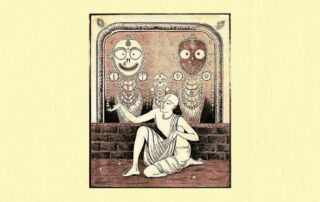Latest Posts
Here you will find all the latest posts on the Bhaktivinoda Institute in the form of Articles, Book Chapters, Songs & Poems etc.
Śrī Śīkṣāṣṭakam Verse Three
Śrīla Bhaktivinoda Ṭhākura’s commentary on Mahāprabhu’s Śikṣāṣṭakam, the Sammodana Bhāṣyam (‘that commentary which gives bliss to the devotees’ ) was written in Sanskrit in 1886. The Ṭhākura gives a detailed explanation of each verse, starting with the mūlā-śloka (verse one), revealing the progressive stages of the sādhaka leading to prema.
Datta Kaustubham – Verses 51-60
Śrīla Bhaktivinoda Ṭhākura’s Datta Kaustubham was written in 1873 at Jagannātha Purī and contains 104 Sanskrit verses with an auto-commentary. This is one of the Ṭhākura’s earliest works in Sanskrit and presents a systematic analysis of sambandha, abhidheya and prayojana. The title ‘Datta Kaustubham’ refers to Kṛṣṇa’s kaustubha-gem of sat-siddhānta (transcendental philosophy) that has been given to Kedaranatha Datta (Bhaktivinoda Ṭhākura). This translation is based upon the Gauḍīya Mission edition printed in 1942.
Śrī Śīkṣāṣṭakam Verse Two
Śrīla Bhaktivinoda Ṭhākura’s commentary on Mahāprabhu’s Śikṣāṣṭakam, the Sammodana Bhāṣyam (‘that commentary which gives bliss to the devotees’ ) was written in Sanskrit in 1886. The Ṭhākura gives a detailed explanation of each verse, starting with the mūlā-śloka (verse one), revealing the progressive stages of the sādhaka leading to prema.
Śrī Brahma-saṁhitā Prakāśinī Commentary – Verses 11-20
Śrīla Bhaktivinoda Ṭhākura’s Prakāśinī commentary to 'Śrī Śrī Brahma-saṁhitā' was written in 1897 and serialised in the Sajjana Toṣaṇī magazine. The Prakāśinī commentary of Brahma-saṁhitā follows in the footsteps of Jīva Gosvāmī's Dig-darśinī commentary.
Śrī Śīkṣāṣṭakam Verse One
Śrīla Bhaktivinoda Ṭhākura’s commentary on Mahāprabhu’s Śikṣāṣṭakam, the Sammodana Bhāṣyam (‘that commentary which gives bliss to the devotees’ ) was written in Sanskrit in 1886. The Ṭhākura gives a detailed explanation of each verse, starting with the mūlā-śloka (verse one), revealing the progressive stages of the sādhaka leading to prema.
Bhagavad-gita – Chapter Ten
Śrīla Bhaktivinoda Ṭhākura’s first Bengali commentary to the Bhagavad-gītā named ‘Rasika-Rañjana’ (‘That which delights the relishers of rasa’) was written in 1886 and was a combined translation/commentary. This commentary was based upon Śrīla Viśvanātha Cakravartī Ṭhākura’s Sārārtha-varṣiṇī commentary. The Ṭhākura also gave an elaborate introduction to this work describing the connection between the paths of karma, jñāna and bhakti.
Datta Kaustubham – Verses 41-50
Śrīla Bhaktivinoda Ṭhākura’s Datta Kaustubham was written in 1873 at Jagannātha Purī and contains 104 Sanskrit verses with an auto-commentary. This is one of the Ṭhākura’s earliest works in Sanskrit and presents a systematic analysis of sambandha, abhidheya and prayojana. The title ‘Datta Kaustubham’ refers to Kṛṣṇa’s kaustubha-gem of sat-siddhānta (transcendental philosophy) that has been given to Kedaranatha Datta (Bhaktivinoda Ṭhākura). This translation is based upon the Gauḍīya Mission edition printed in 1942.
Śrī Brahma-saṁhitā Prakāśinī Commentary – Verses 1-10
Śrīla Bhaktivinoda Ṭhākura’s Prakāśinī commentary to 'Śrī Śrī Brahma-saṁhitā' was written in 1897 and serialised in the Sajjana Toṣaṇī magazine. The Prakāśinī commentary of Brahma-saṁhitā follows in the footsteps of Jīva Gosvāmī's Dig-darśinī commentary.
Śrī Brahma-saṁhitā – Introduction
Śrīla Bhaktivinoda Ṭhākura’s Prakāśinī commentary to 'Śrī Śrī Brahma-saṁhitā' was written in 1897 and serialised in the Sajjana Toṣaṇī magazine. The Prakāśinī commentary of Brahma-saṁhitā follows in the footsteps of Jīva Gosvāmī's Dig-darśinī commentary.
Bhagavad-gita – Chapter Nine
Śrīla Bhaktivinoda Ṭhākura’s first Bengali commentary to the Bhagavad-gītā named ‘Rasika-Rañjana’ (‘That which delights the relishers of rasa’) was written in 1886 and was a combined translation/commentary. This commentary was based upon Śrīla Viśvanātha Cakravartī Ṭhākura’s Sārārtha-varṣiṇī commentary. The Ṭhākura also gave an elaborate introduction to this work describing the connection between the paths of karma, jñāna and bhakti.
Datta Kaustubham – Verses 31-40
Śrīla Bhaktivinoda Ṭhākura’s Datta Kaustubham was written in 1873 at Jagannātha Purī and contains 104 Sanskrit verses with an auto-commentary. This is one of the Ṭhākura’s earliest works in Sanskrit and presents a systematic analysis of sambandha, abhidheya and prayojana. The title ‘Datta Kaustubham’ refers to Kṛṣṇa’s kaustubha-gem of sat-siddhānta (transcendental philosophy) that has been given to Kedaranatha Datta (Bhaktivinoda Ṭhākura). This translation is based upon the Gauḍīya Mission edition printed in 1942.
Reflections
Reflections by Bhaktivinoda Ṭhākura This English poem 'Reflections' was written by Bhaktivinoda Ṭhākura in 1871. The poem was prefaced by the words, “Thoughts on popular topics Read More...
Bhagavad-gita – Chapter Eight
Śrīla Bhaktivinoda Ṭhākura’s first Bengali commentary to the Bhagavad-gītā named ‘Rasika-Rañjana’ (‘That which delights the relishers of rasa’) was written in 1886 and was a combined translation/commentary. This commentary was based upon Śrīla Viśvanātha Cakravartī Ṭhākura’s Sārārtha-varṣiṇī commentary. The Ṭhākura also gave an elaborate introduction to this work describing the connection between the paths of karma, jñāna and bhakti.
Datta Kaustubham – Verses 21-30
Śrīla Bhaktivinoda Ṭhākura’s Datta Kaustubham was written in 1873 at Jagannātha Purī and contains 104 Sanskrit verses with an auto-commentary. This is one of the Ṭhākura’s earliest works in Sanskrit and presents a systematic analysis of sambandha, abhidheya and prayojana. The title ‘Datta Kaustubham’ refers to Kṛṣṇa’s kaustubha-gem of sat-siddhānta (transcendental philosophy) that has been given to Kedaranatha Datta (Bhaktivinoda Ṭhākura). This translation is based upon the Gauḍīya Mission edition printed in 1942.
Bhagavad-gita – Chapter Seven
Śrīla Bhaktivinoda Ṭhākura’s first Bengali commentary to the Bhagavad-gītā named ‘Rasika-Rañjana’ (‘That which delights the relishers of rasa’) was written in 1886 and was a combined translation/commentary. This commentary was based upon Śrīla Viśvanātha Cakravartī Ṭhākura’s Sārārtha-varṣiṇī commentary. The Ṭhākura also gave an elaborate introduction to this work describing the connection between the paths of karma, jñāna and bhakti.













